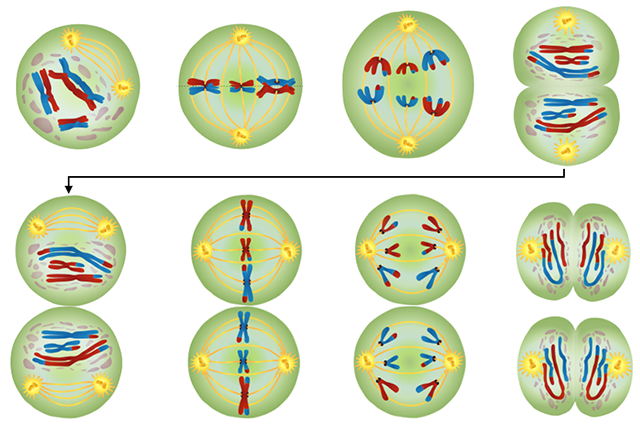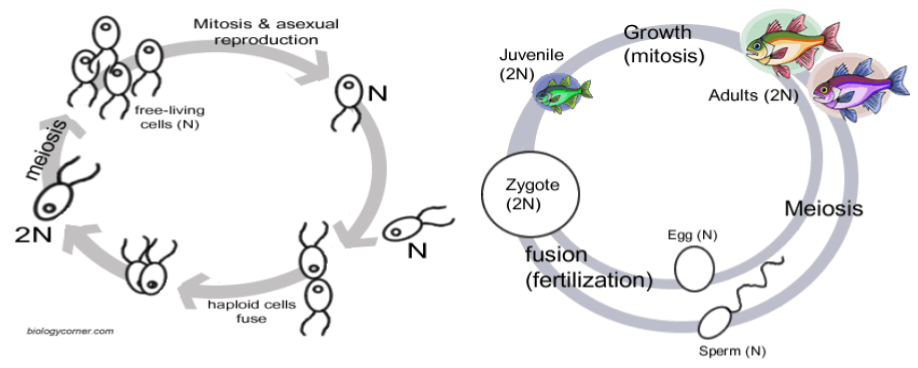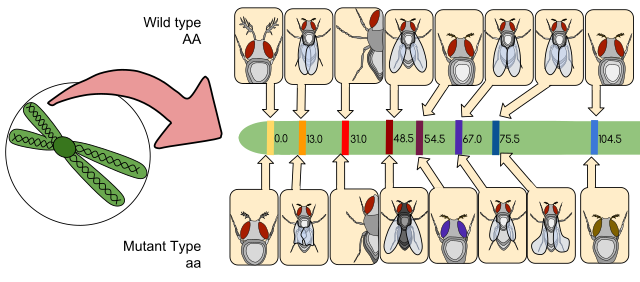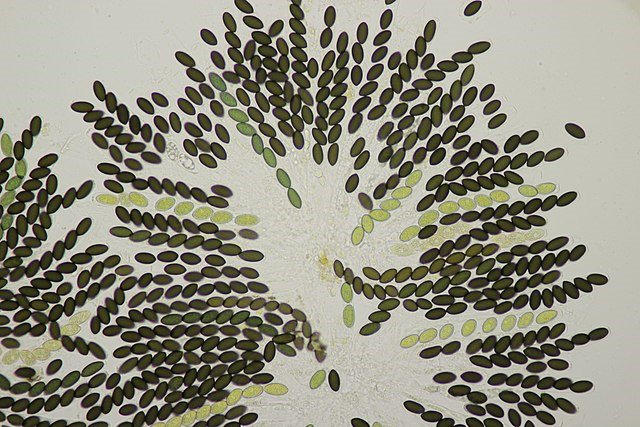Meiosis - AP Biology
Meiosis is a type of cell division that reduces the chromosome number by half, resulting in the production of gametes (sperm and eggs) in animals or spores in plants and fungi.
Chromosome Structure
- occurs in pairs (homologs)
- one came from your father, one from your mother
- chromosomes contain genes which also occur in pairs
Homologous Chromosomes
- pairs of chromosomes
-
same size and shape
- contain genes
- each gene has two alleles which may be different versions of the gene
- Ex. Short hair (H) or long hair (h)
Sex Chromosomes (in humans)
XX = Female XY = Male
Diploid vs Haploid
Body cells have a full set of chromosomes - DIPLOID (in humans, 46)
Sex cells (sperm and egg) have half a set - HAPLOID (in humans, 23)
Diploid numbers vary by species; dogs have 78 chromosomes
Meiosis and Sexual Reproduction
Meiosis - the production of haploid cells with unpaired chromosomes (word means "to diminish")
-process creates gametes (sperm and egg), cells that are haploid (1N)
- gametes combine to create a zygote, which is 2N
Key Points of Meiosis
- results in 4 daughter cells
- daughter cells are haploid (N)
- daughter cells have unique combinations of chromosomes
Crossing Over and Genetic Variation
During prophase 1, homologous chromosomes pair up in a process called synapsis
Chromosomes exchange DNA - this is called crossing-over
During Metaphase, chromosomes line up in pairs, but how they line up is random
- results in many different arrangements of chromosomes

Phases of Meiosis
Meiosis 1
Prophase 1 - homologous chromosomes pair up; crossing over occurs
Metaphase 1 - tetrads align in the center
Anaphase 1 - homologous chromosomes are pulled apart
Telophase 1 - chromosomes arrive at the poles, cell divides into two haploid cells (cytokinesis)
Meiosis 2
Prophase 2 - chromosomes condense, new spindle forms
Metaphase 2 - chromosomes align individually in center
Anaphase 2 - sister chromatids are pulled to opposite poles
Telophase 2 - chromatids reach the pole and cell divides into 4 haploid gametes

Spermatogenesis - the production of male sex cells (sperm)
- results in four equal gametes that are motile with flagella
Oogenesis - the production of female sex cells (oocytes or eggs)
- results in 1 primary oocyte and 3 smaller polar bodies
Fertilization - combining the genes of two different parents
Offspring show variation due to independent assortment and crossing over
Offspring are unique!
Modeling Meiosis in Fruit Flies
Haploid vs Diploid Life Cycles
The haploid and diploid life cycles describe how organisms alternate between different numbers of chromosome sets during their reproductive cycles. These terms refer to the number of chromosome sets in a cell:
- Haploid (n): A single set of chromosomes (e.g., sperm, eggs, or spores).
- Diploid (2n): Two sets of chromosomes, one from each parent (e.g., most body cells in humans).

Alternation of Generations Worksheet
Chromosomes and Map Units
Chromosome map units, also known as centimorgans (cM), are a way to measure the relative distance between genes on a chromosome. They indicate the likelihood of recombination between two genes during meiosis.
Ganetes with unique combinations of genes are called recombinants.
Scientists determine the distaance genes are on a chromosome by thre frequency of crossover.
1 map unit (1 cM) = 1% chance of recombination between two genes.
Example: If two genes are 10 map units apart, there is a 10% chance they will recombine during meiosis

Meiosis in Sordaria - Laboratory Investigation
Life Cycle of Sordaria

Haploid Vegetative Growth
Mycelium Formation:
Sordaria primarily exists as haploid (n) mycelium, which consists of thread-like structures called hyphae.
These hyphae grow and spread by mitotic division, absorbing nutrients from their environment.
Most of the mass of the fungus consists of haploid cells
Fertilization produces a diploid zygote, which undergo meiosis to form 4 haploid nuclei
These haploid nuclei divide once by mitosis to produce eight haploid ascosspores
Meiosis:
The diploid nucleus undergoes meiosis to produce four haploid nuclei.
Mitosis:
These haploid nuclei divide once more by mitosis, resulting in eight haploid ascospores
Each is encased in a structure called an ascus when is then encased in a structure called the perithecium